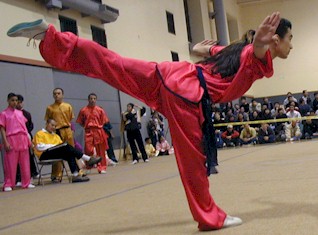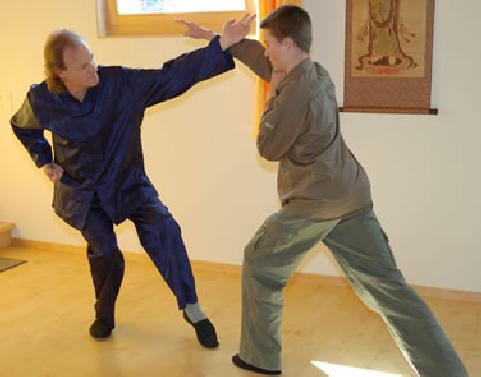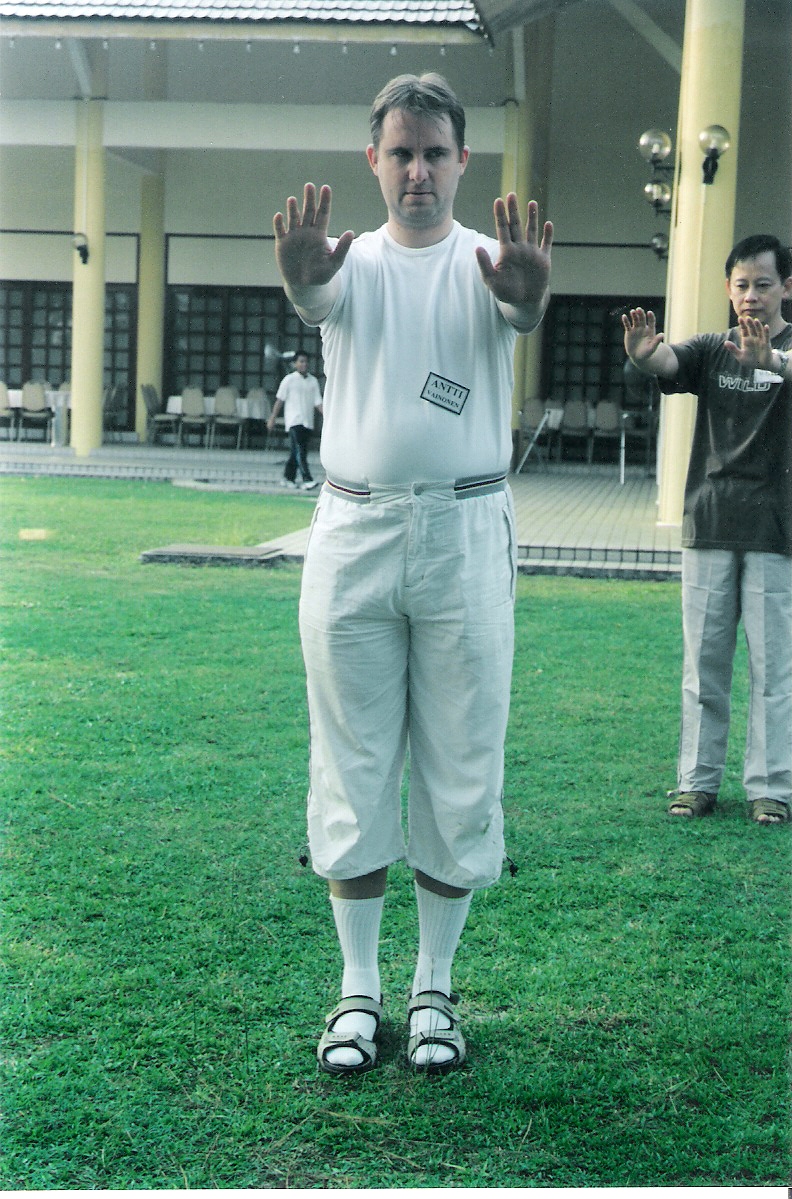January 2008 (Part 2)
SELECTION OF QUESTIONS AND ANSWERS

Modern wushu is a magnificent art and requires dedication to master, but it is different from traditional kungfu. The picture above, reproduced from http://www.csc.gov.sg/html/newsletter/aug2005/c46.html shows a wushu demonstration.
Question 1
If I have dishonored you in any way, I am very sorry. Please forgive me. Sometimes I forget I'm only 14 and I don't always get what I want.
— Nicholas, USA
Answer
Please don't worry. You have not dishonored me or my school in any way whatsoever. In fact, I like your questions, and you are respectful. I am impressed with your maturity when you are only fourteen.
Question 2
Also I still have a few more questions to ask you. Is Shaolin Wahnam the name of your school, or is it a different art than Shaolin Kung Fu?
Answer
Shaolin Wahnam is the name of my school. Shaolin Kungfu is the style of kungfu we practice. “Wahnam” is named in honour of my two teachers, namely Sifu Lai Chin Wah and Sifu Ho Fatt Nam.
Question 3
And is Shaolin Kung Fu translated in Chinese as “wushu” or is it a different martial art?
Answer
The term “kungfu” is translated as “wushu” in Chinese. There are many styles of kungfu. Shaolin Kungfu is one of these many styles. It is also the most famous.
In Chinese, “Shaolin Kungfu” is written as “Shao Lin Wu Shu”. Kungfu has a very long history. Therefore, there are also other Chinese translations for “kungfu”. “Wushu” is one of them. It is the term used nowadays especially in mainland China.
But overseas Chinese in Southeast Asia, America, Europe and Australia usually use the term “kungfu”, although they also sometimes use the term “wushu”.
Another Chinese term for kungfu is “quan-fa”. It is an older term than “wushu”. “Quan-fa” is oftern shortened to “quan”. (“Quan” is pronounced like “chuan”.) So Shaolin Kungfu, which is “Shao Lin Wu Shu” in Chinese, is also called “Shao Lin Quan Fa”, shortened to “Shao Lin Quan”.
Another famous style of kungfu is Taijiquan. In Chinese it is writtern as “Tai Ji Quan”, which is the shortened form of “Tai Ji Quan Fa”. In English, Taijiquan is usually spelt as “Tai Chi Chuan”.
An even older Chinese translation for kungfu is “wu-yi”. So in older Chinese literature, Shaolin Kungfu was written as “Shao Lin Wu Yi”. This term “wu-yi” was older than Taijiquan. So Taijiquan was seldom called “Tai Ji Wu Yi”. It is also seldom called “Tai Ji Wu Shu”, probably because the term “Tai Ji Quan” has become established.
Therefore, what we call “kungfu” in English is called “wu-yi”, “quan-fa” and “wushu” in Chinese. However, the term “wushu” often presents some complications. But the following brief historical explanation may clear the complications.
When the present Chinese government came to power in 1945, kungfu which was called “wushu”, was considered bourgeois, and therefore taboo. But there was a change of policy in the 1970s. The Chinese government reconstructed countless traditional kungfu forms into just seven forms, and called these forms by the general name “wushu”.
In the past there were different styles of kungfu, like Shaolin, Taijquan, Hoong Ka, Wing Choon, Praying Mantis and Eagle Claw, but since the reconstruction they were just called “wushu”. More significantly, wushu was not promoted as a martial art but as a sport. Hence, although the term means “martial art”, when we talk of “wushu” today, it refers to a sport.
The forms practiced in wushu are similar to traditional kungfu forms, but there is no internal force training and no combat application in modernized wushu. In the late 1980s free sparring was attempted by some wushu practitioners, but they used Boxing and Kick-Boxing techniques, and not wushu forms for the sparring.
Free sparring is called “san-da” in Chinese. In the past, kungfu practitioners logically used kungfu forms in their “san-da” or free sparring. But today “san-da” practitioners use Boxing or Kick-Boxing.

Internal force training and combat application are normally not part of wushu training, but they are essential in genuine, traditional Shaolin Kungfu. The picture above shows Sifu Andrew Barnett of Shaolin Wahnam Switzerland sparring with his son, Bjoern.
Question 4
I want to learn Shaolin Kung Fu for every benefit it gives. I can tell you now I don't feel healthy. I can't really spar like I wish to. And even though I'm Christian, I believe that every good philosophy and spiritual well being will agree with my faith.
Answer
What I am going to say may come as a big surprise and disappointment to you, and may be offensive to many other people. But I would like to tell the truth, especially to a young, sincere enquirer like you.
It is sad but true that there is little benefit in much of the Shaolin Kungfu, including modern Shaolin Wushu, practiced today. Benefits like good health, combat efficiency, moral development and spiritual cultivation — benefits that many aspiring students of Shaolin Kungfu hope to have — are not found. Instead you may find benefits like opportunities to demonstrate in public and to win competitiones.
Many Shaolin kungfu and wushu practitioners suffer from knee injuries. Those who engage in free sparring sustain internal injuries that are routinely left unattended to. This is not conducive to good health.
Many Shaolin kungfu and wushu practitioners only practice kungfu forms and never learn combat application. Those who attempt free sparring use Kick-Boxing or other martial art techniques but not the kungfu or wushu forms they learn. Some of them may be good at hitting people, but they cannot defend themselves. They may not realize it but this is evident in their mistaken concept that taking punches and kicks is a necessary part of sparring.
Winning competitions is much emphasized in many schools. The desire to win, often at all cost, often results in poor sportsmanship and unhealthy rivalry.
Instead of being relaxed and calm, which are characteristics of an ideal martial artist, practitioners usually tense their muscles and are mentally stressful in their training. Because they are being routinely hit in free sparring, they often become angry and aggressive.
Those who merely practice demonstrative forms, and never spar, realize they have missed something important, but they lack the honesty to admit it nor the courage to rectify their inadequacy. All these are not conducive to moral development.
Spiritual cultivation may be talked about but is little understood and almost never experienced. Most practitioners today pay attention only to the physical, and have little or no concept of the spiritual.
At best they equate spiritual cultivation to moral development, which is not actually the same. Morality is the basic of spiritual training, but by itself it is different. Morality may or may not be spiritual. A morally upright person may just be physical, without any inkling of the spiritual. Spiritual cultivation means cultivating the spirit, or soul or mind. Many practitioners do not even believe the spirit, soul or mind exists.
But not all is lost. There are still masters who teach Shaolin Kungfu that brings benefits of good health, combat efficiency, moral development and spiritual cultivation. We call such Shaolin Kungfu, which is very rare today, genuine, traditional Shaolin Kungfu. Risking ourselves to be called egoistic, we are proud to say that Shaolin Wahnam was establishrd to teach and preserve genuine, traditional Shaolin Kungfu.
If you practice genuine, traditional Shaolin Kungfu, you will certainly be healthy and able to use kungfu forms to spar and fight effectively. Genuine, traditional Shaolin Kungfu is spiritual, but it is not religious. If he is deserving, a person of any religion, or of no official religion, can practice and benefit much from genuine, traditional Shaolin Kungfu.
As a result of the Shaolin training he usually becomes more devoted to his own religion because the training enables him to directly experience many of the teachings in his religion. For example, love and faith are two very important aspects in Christian teaching. In moments of deep meditation in his advanced training, he directly experiences, not merely talks about, love for humanity and faith in the Supreme. He becomes a more devoted Christian as these two crucial aspects of Christian teaching become personally meaningful to him.
Practitioners of genuine, traditional Shaolin Kungfu honour the religion of others, even when they may not agree with some of the religious beliefs. You may be pleased to know that many Shaolin masters were Christian, besides Buddhist, Taoist and Muslim. Disciples of different religions practiced and lived together happily and peacefully in the Shaolin Temple in the past, and they now do in our Shaolin Wahnam Family.
Question 5
I would like to ask a question I have been thinking from time to time and do not really seem to see recommendations anywhere. For an average person doing some martial arts with some basic chi kung, what would be a good way to deal with one's training when having a common cold, including blocked sinuses? Should one simply take a complete break until symptoms go, or are there some exercises that one could do profitably?
— Dr Pitkanen, UK
Answer
There are a few effective ways to deal with your common cold and blocked sinuses.
A good way is to take a hot drink, then perform a vigorous kungfu set so that you may sweat profusely. Dry yourself, then keep yourself warm.
Another good way is to take a hot drink, then perform some chi kung exercises that induce self-manifested chi movement. After the vigoros chi movement, dry yourslf and keep warm.
A third way is to practice some chi kung breathing exercises, like Abdominal Breathing. After the exercise, lie in bed for some time, then get out from bed and go for a brisk walk, preferably in a garden or in surrunding with green trees.
Question 6
I have been going through some health issues in the last year and a half and would like to seek some assistance from you. I believe I have some underlying chronic fatigue type disorder. I have had numerous blood tests and have found a few things that point to this recently.
Unfortunately Western doctors haven't been much use, all that they've suggested is to try anti-depressants, which I tried to avoid for a while but have finally given in. In the last few months I have also developed heat activated hives (cholinergic urticaria) which is related to the underlying problems.
I have your book “The Art of Chi Kung” and have attended a short course from one of your instructors in Brisbane. Recently I have tried to start my practice of “Lifting the Sky” after a period of severe fatigue and have found that it now triggers the hives (itching all over my body and a rash). This makes it somewhat difficult to perform the exercise as it takes my mind away from a relaxed state. The itching is the most irritable part, it can get quite painful.
— John, Australia
Answer
I believe you have learnt form Dr Neil Kelson or Sifu Jeffrey Segal, two of our best certified Shaolin Wahnam instructors teaching in Australia. In either case, you should call me “Sigung”, which refers to the teacher of one's teacher's.
In chi kung training, it is very important to practice regularly, i.e. once in the morning and once in the evening or at night every day, so as to get the benefit of gradually accumulated effect. If you practice only once a while, you may have some novel sensations, but not lasting good result.
Each training session takes about 15 minutes. You can use any one of the exercises you have learnt from your sifu, and practice it for about 5 to 8 minutes to induce a chi flow. Then you let go and enjoy the chi flow for another 5 to 8 minutes. It is the chi flow that is most important; the preliminary chi kung exercise is just a technique to get the chi flowing.
Your fatigue-type disorder is due to energy being blocked from performing its normal functions. This also affects the natural chemical production in your body, resulting in your itchy hives. Alternatively the hives could be an indication of chi cleansing out toxins due to your abuse of your body in the past.
Each time you have your chi flow, the flow will break through some blockages. If you persist enough, the regular chi flow will break through all the blockages. When this happens, you will restore your natural functions and your fatigue-type disorder and itchy hives will disappear as a matter of course. Meanwhile if the itches are too uncomfortable, you can apply some suitable medication as an ad hoc measure.

To have good results, chi kung must be practiced everyday. The picture shows Antti of Shaolin Wahnam Finland practicing a Shaolin chi kung exercise known as "Pushing Mountains".
Question 7
Are there any other stationary chi kung I can perform until I can overcome the hives? I also practice some tai chi that I learnt while training in kung fu locally which doesn't activate the hives. Any assistance you can provide would be greatly appreciated.
I have gone to a number of practitioners of alternative therapies (with varying degrees of success, but no complete relief), a Chinese herbalist amongst them, and would dearly like to get back to my former life which I have been robbed of (I do take responsibility for this however as I didn't treat my body as I should have for a period of time).
Answer
It may sound ridiculous to those who view health and sickness from a conventional Western perspective, but from the chi kung perspective any chi kung exercise that generates a chi flow will be effective to overcome your problems. It is the chi flow, not the exercise itself that does the work.
As an analogy, you need cash flow to pay for your economic needs, like paying your rent and buying your meals. If for any reasons your cash flow is blocked, you would encounter economic problems. To restore your cash flow, you have to take on a job that pays you money. It does not matter what job you will do so long as it is paying well to restore your cash flow. Your job is a mean. Once your cash flow is restored, you will be able to overcome your economic problems.
In the same way, chi kung exercises are means to generate energy flow. Once you have restored your energy flow, you will be able to overcome your health problems.
Question 8
I feel like a burden upon my parents whom I am living with at the moment, and would like to one day repay them for the care that they have given me in this time.
Answer
Parents always do their best for their children and never expect any rewards in return. You should be determined to practice chi kung everyday and get well. Then you can repay your parents.
There are many ways to repay your parents. Unless they are in financial difficulty, receiving money and gifts from you is low in their priority. They would very much prefer you to spend some quality time with them as often as possible.
LINKS
Selected Reading
- Shaolin Seven Two Chin-Na Techniques
- Various Ways to Fell an Opponent
- A Comparative Study of Taijiquan and Shaolinquan
- Secrets in Free Sparring Methodology
- Can your Responses still be Correct and Spontaneous in Real Fights
